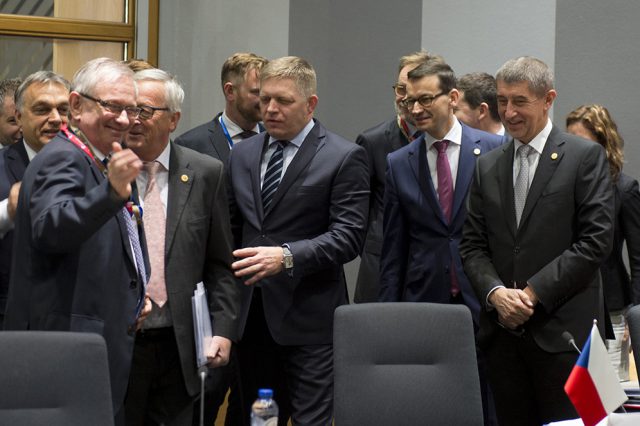
In 2016, the United Kingdom’s Brexit referendum and Donald Trump’s election to the US presidency created an impression that Eastern European–style populism was engulfing the West. In reality, the situation in Western Europe and the United States is starkly different.
As political scientists Martin Eiermann,
Yascha Mounk and Limor Goultchin of the Tony Blair Institute for Global Change have
shown, only in Europe’s post-communist east do populists routinely beat traditional parties in elections. Of 15 Eastern European countries, populist parties currently hold power in seven, belong to the ruling coalition in two more, and are the main opposition force in three.
Eiermann, Mounk and Goultchin also point out that whereas populist parties captured 20% or more of the vote in only two Eastern European countries in 2000, today they have done so in 10 countries. In Poland, populist parties have gone from winning a mere 0.1% of the vote in 2000 to holding a parliamentary majority under the Law and Justice (PiS) party’s current government. And in Hungary, support for Prime Minister Viktor Orbán’s Fidesz party has at times exceeded 70%.
Aside from hard data, we need to consider the underlying social and political factors that have made populism so much stronger in Eastern Europe. For starters, Eastern Europe lacks the tradition of checks and balances that has long safeguarded Western democracy. Unlike PiS Chairman Jarosław Kaczyński, Poland’s de facto ruler, Trump does not ignore judicial decisions or sic the security services on the opposition.
Or consider Special Counsel Robert Mueller’s investigation into Trump and his campaign’s ties to Russia. Mueller was appointed by Deputy Attorney General Rod Rosenstein, a government functionary who is subordinate to Trump within the executive branch. But while Trump has the authority to fire Mueller or Rosenstein, he wouldn’t dare do so. The same cannot be said for Kaczyński.
Another major difference is that Eastern Europeans tend to hold more materialist attitudes than Westerners, who have moved beyond concerns about physical security to embrace what sociologist Ronald Inglehart calls
post-materialist values. One aspect of this difference is that Eastern European societies are more vulnerable to attacks on abstract liberal institutions such as freedom of speech and judicial independence.
This shouldn’t be too surprising. After all, liberalism in Eastern Europe is a Western import. Notwithstanding the Trump and Brexit phenomena, the US and the UK have deeply embedded cultures of political and social liberalism. In Eastern Europe, civil society is not just weaker; it is also more focused on areas such as charity, religion, leisure and politics, rather than social issues.
Moreover, in the vastly different political landscape of Europe’s post-communist states, the left is either very weak or completely absent from the political mainstream. The political dividing line, then, is not between left and right, but between right and wrong. As a result, Eastern Europe is much more prone to the ‘friend or foe’ dichotomy conceived by the anti-liberal German political and legal theorist Carl Schmitt. Each side conceives of itself as the only real representative of the nation, and treats its opponents as illegitimate alternatives, who should be disenfranchised, not merely defeated.
Another major difference between Eastern and Western European populists is that the former can count on support not only from the working class, but also from the middle class. According to
research conducted by Maciej Gdula of the Institute of Advanced Study in Warsaw, political attitudes in Poland do not align with whether one benefited or lost out during the country’s post-communist economic transformation. The ruling party’s electorate includes many who are generally satisfied with their lives, and are keeping up with the country’s development.
For such voters, the appeal of the populist’s message lies in its provision of an overarching narrative in which to organise positive and negative experiences. This creates a sense of purpose, as it ties voters more strongly to the party. Voters do not develop their own opinions about the courts, refugees or the opposition based on their own experiences. Instead, they listen to the leader, adjusting their views according to their political choices.
The success of the PiS, therefore, is rooted not in frustrated voters’ economic interests. For the working class, the desire for a sense of community is the major consideration. For their middle-class counterparts, it is the satisfaction that arises not from material wealth, but from pointing to someone who is perceived as inferior, from refugees to depraved elites to cliquish judges. Orbán and Kaczyński are experts in capitalising on this longing.
It is worth asking if populism will come to define the true cultural—and, in turn, political—boundaries of the European Union. If Polish or Hungarian politics proves more similar to the politics of Russia than of France or Austria, does that mean the EU’s borders are overextended? Could it be that their place is with Russia, rather than with Western Europe? Are the EU’s borders therefore impossible to maintain in the long run?
These are troubling questions. And only Eastern Europeans themselves can settle them.
 Print This Post
Print This Post